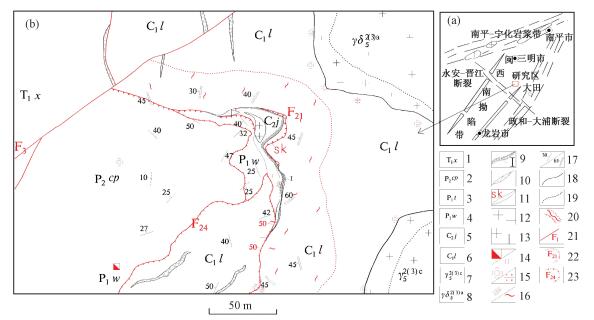PHYSICAL-CHEMICAL CONDITIONS FOR MINERALIZATION OF THE QINSHAN IRON DEPOSIT IN DATIAN COUNTY, FUJIAN PROVINCE
-
摘要: 在野外地质工作基础上, 通过流体包裹体和氢氧同位素研究, 探讨福建大田琴山铁矿床形成的物理化学条件。流体包裹体研究显示, 均一温度均值355.6 ℃, 盐度(NaCl质量分数)均值4.4%, 流体密度均值0.65 g/cm3。流体演化成矿经历了400~420 ℃和240~280 ℃两个主要阶段, 其中400~420 ℃为晚矽卡岩阶段磁铁矿主要成矿温度, 形成深度约3 km, 该阶段以混合作用为主; 240~280 ℃为晚硫化物阶段铅锌矿主要成矿温度, 形成深度约1 km, 以沸腾作用为主。激光拉曼测试结果显示, 成矿流体含少量CH4和CO2。氢氧同位素显示, 早期成矿流体主要以岩浆水为主, 晚期成矿流体混入大量大气降水。研究结果表明琴山铁矿属于热液矽卡岩型矿床。Abstract: Based on field investigation, the forming physical and chemical conditions of Qinshan iron deposit in Datian, Fujian were researched by fluid inclusions measurement and hydrogen and oxygen isotope. The homogenization temperature of fluid inclusions was 355.6 ℃, the salinity was 4.4%NaCl and the density was 0.65 g/cm3. Two peaks of homogenization temperature indicated that there were two stage of ore-fluid in the process of mineralization. The earlier stage was close related with the magnetite metallogenisis on the later skarn stage and the depth of about 3 km, the homogenization temperature was 400~420 ℃. The later stage was the Pb-Zn metallogenic stage and the depth of about 1 km, the fluid temperature was 240~280 ℃ and boiling. Raman analysis showed that the ore forming fluids contained little CO2 and CH4. The hydrogen and oxygen isotope data showed that the ore forming fluid mostly was derived from magma, and mixed with lot of meteoric water at later stage. Overall, the Qinshan Iron deposit was interpreted as a hydrothermal skarn deposit.
-
图 1 闽西南地区构造纲要图(a)和琴山铁矿矿区地质简图(b)(福建省地质调查研究院,2012)
1—早三叠世溪口组;2—晚二叠世翠屏山组;3—早二叠世童子岩组;4—早二叠世文笔山组;5—晚石炭世经畲组;6—早石炭世林地组;7—燕山早期第三阶段第三次侵入岩中细粒钾长花岗岩;8—燕山晚期第一阶段第三次侵入岩中细粒花岗闪长岩;9—铁矿体及编号;10—铁锰矿化蚀变带;11—矽卡岩化带;12—花岗闪长岩;13—钾长花岗岩;14—褐铁矿化/黄铁矿化;15—硅化/云英岩化;16—矽卡岩化/绿泥石化;17—层理产状/片理产状;18—地质界线;19—岩相界线;20—动力变质带;21—断层及编号;22—滑脱断层及编号;23—推覆断层及编号
Figure 1. Geological sketch map of the Qinshan iron ore district and tectonic outline map of the Minxinan region
表 1 流体包裹体显微测温结果
Table 1. Microthermometric data from fluids inclusions in the Qinshan iron deposi
样号(测点数) 样品类型 包裹体类型 充填度 均一温度/℃ 冰点温度/℃ 盐度/% 密度/(g·cm-3) 压力/MPa 深度/km 范围 均值 范围 均值 范围 均值 QSQ-3(2) 石榴子石-黄铁矿 Ⅰ 30 285~312 298.5 -0.1~-2.2 -1.1 0.18~3.71 1.94 0.74 8.30 0.83 QSQ-2(5) 石榴子石 50~70 386~402 395.3 -3.3~-6.8 -5.18 5.41~10.20 8.03 0.62 6.21 0.62 QPD3-1(8) 磁铁矿-石英脉 30~50 260~407 369.1 -0.1~-4.8 -3.74 0.18~7.59 6.05 0.65 19.90 1.99 QPD3-3(7) 磁铁矿-石英脉 20~40 239~343 270.1 -0.1~-1.8 -0.71 0.18~3.55 1.22 0.78 5.48 0.55 QPD3-4(8) 磁铁矿-石英脉 10~30 276~385 336.1 -0.1~-1.7 -0.63 0.18~2.90 1.08 0.77 5.72 0.57 QSQ-5(9) 黄铁矿-石英脉 20~31 185~248 231.7 -0.1~-3.7 -1.17 0.18~6.01 1.95 0.84 2.85 0.29 QPD2-1(5) 黄铁矿-石英脉 40~50 262~291 278.0 -0.7~-0.9 -0.80 1.22~1.57 1.40 0.84 6.18 0.62 QPD3-2(5) 石英脉 20~40 231~272 250.3 -0.3~-0.9 -0.55 0.53~1.57 0.96 0.81 3.97 0.40 QPD3-7(7) 石英脉 20~40 178~268 209.6 -2.4~-4.6 -3.36 4.03~7.31 5.47 0.90 1.83 0.18 QPD2-2(8) 石英脉-方铅矿-闪锌矿 20~30 140~320 248.5 -0.1~-1.5 -0.44 0.18~2.57 0.84 0.84 3.86 0.39 QSQ-1(3) 石榴子石 Ⅱ 50~60 398~427 412.0 -3.1~-5.9 -3.86 5.11~9.08 6.21 0.55 30.10 3.01 QSQ-4(4) 石榴子石-黄铁矿 20-30 401~470 432.9 -0.1~-11.5 -3.90 1.18~15.40 5.63 0.51 31.54 3.15 注:测试在南京大学内生金属矿床成矿机制研究国家重点实验室完成。WNaCl=0.00+1.78Tm-4.42×10-2Tm2+ 5.57×10-4 Tm3,Tm为冰点温度的绝对值(Hall等, 1988);密度和最小压力参考NaCl-H2O流体体系估算[9] 表 2 氢、氧同位素组成
Table 2. Hydrogen and oxygen isotopic compositions from the Qinshan iron deposit
样品 产状 矿物 t/℃ δ18O石英/‰ δD流体/‰ δ18OH2O/‰ QPD2-1 石英-黄铁矿 石英 278 1.9 -54 -5.8 QPD2-2 石英脉-方铅矿-闪锌矿 石英 250 1.3 -51 -7.7 QPD3-1 磁铁矿-石英脉 石英 369 12.3 -53 7.5 QPD3-2 石英-黄铁矿 石英 270 4.1 -62 -4.0 QPD3-4 磁铁矿-石英脉 石英 336 10.4 -54 4.7 注:样品由中国地质科学院矿产资源研究所分析,计算采用的分馏方程为δ18O石英-δ18O水=1000lnα石英-水=3.38×106/T2-3.40[12] -
[1] 林喜.福建大田琴山铁矿地质特征及成因初探[J].福建地质, 2011, 30(2):101~106. http://www.cnki.com.cn/Article/CJFDTOTAL-FJDZ201102002.htmLIN Xi. Preliminary study of the genesis and the geologic characteristics of the Qinshan iron ore in Datian County, Fujian Province[J]. Gelolgy of Fujian, 2011, 30(2): 101~106. http://www.cnki.com.cn/Article/CJFDTOTAL-FJDZ201102002.htm [2] 范旭光, 刘德民, 李德威.闽西南大田地区中生代岩浆岩特征及构造环境演化[J].华南地质与矿床, 2011, 27(3):201~207. http://www.cnki.com.cn/Article/CJFDTOTAL-HNKC201103006.htmFAN Xu-guang, LIU De-min, LI De-wei. Geochemical characteristics and tectonic significance of Mesozoic magmatic rocks from Datian, Southwestern Fujian[J]. Geology and Mineral Resources of South China, 2011, 27(3): 201~207. http://www.cnki.com.cn/Article/CJFDTOTAL-HNKC201103006.htm [3] 毛建仁, 许乃政, 胡青, 等.福建省上杭—大田地区中生代成岩成矿作用与构造环境演化[J].岩石学报, 2004, 20(2):285~296. http://www.cnki.com.cn/Article/CJFDTOTAL-YSXB200402009.htmMAO Jian-ren, XU Nai-zheng, HU Qing, et al. The Mesozoic rock-forming processes and tectonic environment evolution in Shanghang-Datian region, Fujian[J]. Acta Petrologica Sinica, 2004, 20(2): 285~296. http://www.cnki.com.cn/Article/CJFDTOTAL-YSXB200402009.htm [4] Clayton R N, O'Neil J R, Mayeda T K. Oxygen isotope exchange between quartz and water[J]. Journal of Geophysical Research, 1972, 77: 3057~3067. doi: 10.1029/JB077i017p03057 [5] 陈进全, 徐兆文, 陈兴高, 等.内蒙古哈达特陶勒盖铅锌矿床成矿物理化学条件研究[J].地质学报, 2013, 87(3):375~383. http://www.cnki.com.cn/Article/CJFDTOTAL-DZXE201303008.htmCHEN Jin-quan, XU Zhao-wen, CHEN Xing-gao, et al. Physical-chemical condition of mineralization of the Hardat Tolgoi Pb-Zn deposit, Inner Mongolia[J]. Acta Geologica Sinica, 2013, 87(3): 375~383. http://www.cnki.com.cn/Article/CJFDTOTAL-DZXE201303008.htm [6] 倪培, 田京辉, 朱筱婷, 等.江西永平铜矿下盘网脉状矿化的流体包裹体研究[J].岩石学报, 2005, 21(5):1339~1346. http://www.cnki.com.cn/Article/CJFDTOTAL-YSXB200505002.htmNI Pei, TIAN Jing-hui, ZHU Xiao-ting, et al. Fluid insclusion studies on footwall stringer system mineralization of Yongping massive copper deposit, Jiangxi Province, China[J]. Acta Geologica Sinica, 2005, 21(5): 1339~1346. http://www.cnki.com.cn/Article/CJFDTOTAL-YSXB200505002.htm [7] 卢焕章, 李秉伦, 沈昆, 等.包裹体地球化学[M].北京:地质出版社, 1990:1~242.LU Huan-zhang, LI Bing-lun, SHEN Kun, et al. Insclusion geochemistry[M]. Beijing: Geological Publishing House, 1990: 1~242. [8] 赵斌, 李统锦, 李昭平.矽卡岩形成的物理化学条件实验研究[J].地球化学, 1983, (3):255~268. http://www.cnki.com.cn/Article/CJFDTOTAL-DQHX198304009.htmZHAO Bin, LI Tong-jin LI Zhao-ping. Experimental study of physico-chemical conditions of the formation of skarns[J]. Geochemica, 1983, (3): 256~268. http://www.cnki.com.cn/Article/CJFDTOTAL-DQHX198304009.htm [9] Drummond S E, Ohmoto H. Chemical evolution and mineral deposition in boiling hydrothermal systems[J]. Economic Geology, 1985, 80(1): 126~147. doi: 10.2113/gsecongeo.80.1.126 [10] 申萍, 沈远超, 李光明, 等.新疆阔尔真阔腊金矿床成矿流体包裹体研究[J].岩石学报, 2004, 20(4):969~976. http://www.cnki.com.cn/Article/CJFDTOTAL-YSXB200404018.htmSHEN Ping, SHEN Yuan-chao, LI Guang-ming, et al. Ore-forming fluid insclusions of Kuoerzhengkuola gold deposit, Xinjiang[J]. Acta Geologica Sinica, 2004, 20(4): 969~976. http://www.cnki.com.cn/Article/CJFDTOTAL-YSXB200404018.htm [11] Shepherd S M F. Characterization and isotope variation in natural waters[C] //Valley J W, Taylor H P Jr, O'Neil J R. Stable isotopes in high temperature geological processes: Reviews in mineralogy. Chantilly VA: Mineralogical Society of America, 1986: 165~184. [12] Hedenquist J W, Lowenstern J B. The role of magmas in the formation of hydrothermal ore deposits[J]. Nature, 1994, 370: 519~527. doi: 10.1038/370519a0 [13] 张理刚.稳定同位素在地质科学中的应用[M].西安:陕西科学技术出版社, 1985:54~250.ZHANG Li-gang. Application of stable isotopes in geological sciences[M]. Xi'an: Shaanxi Science and Technology Press, 1985: 54~250. -





 下载:
下载:







